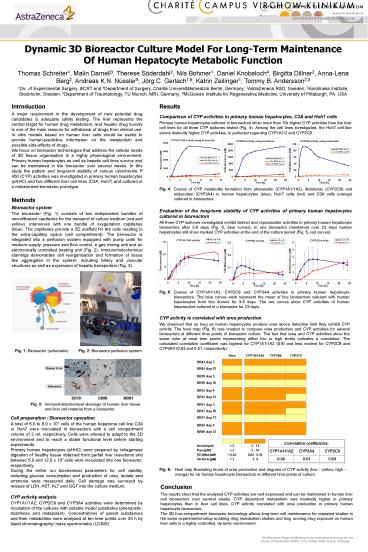Folie 1 - PowerPoint PPT Presentation
1 / 1
Title:
Folie 1
Description:
Dynamic 3D Bioreactor Culture Model For Long-Term Maintenance Of Human Hepatocyte Metabolic Function Thomas Schreiter1, Malin Darnell3, Therese S derdahl2, Nils ... – PowerPoint PPT presentation
Number of Views:37
Avg rating:3.0/5.0
Title: Folie 1
1
Dynamic 3D Bioreactor Culture Model For Long-Term
Maintenance Of Human Hepatocyte Metabolic Function
Thomas Schreiter1, Malin Darnell3, Therese
Söderdahl2, Nils Bohmer1, Daniel Knobeloch4,
Birgitta Dillner2, Anna-Lena Berg2, Andreas K.N.
Nüssler5, Jörg C. Gerlach1,6, Katrin Zeilinger1,
Tommy B. Andersson2,3 1Div. of Experimental
Surgery, BCRT and 4Department of Surgery, Charité
Universitätsmedizin Berlin, Germany 2AstraZeneca
RD, Sweden 3Karolinska Institute, Stockholm,
Sweden 5Department of Traumatology, TU Munich,
MRI, Germany 6McGowan Institute for Regenerative
Medicine, University of Pittsburgh, PA, USA
Introduction A major requirement in the
development of new potential drug candidates is
adequate safety testing. The liver represents the
central target for human drug metabolism, and
hepatic drug toxicity is one of the main reasons
for withdrawal of drugs from clinical use. In
vitro models based on human liver cells would be
useful to provide human-predictive information on
the metabolism and possible side-effects of
drugs. We focus on bioreactor technologies that
address the cellular needs of 3D tissue
organisation in a highly physiological
environment. Primary human hepatocytes as well as
hepatic cell lines survive and can be maintained
in the bioreactor over several weeks. In this
study the pattern and long-term stability of
various cytochrome P 450 (CYP) activities was
investigated in primary human hepatocytes (pHHC)
and two different liver cell lines (C3A, Huh7)
and cultured in a miniaturized bioreactor
prototype.
Results
Comparison of CYP activities in primary human
hepatocytes, C3A and Huh7 cells Primary human
hepatocytes cultured in bioreactors show more
than 10x higher CYP activities than the liver
cell lines for all three CYP isoforms tested
(Fig. 4). Among the cell lines investigated, the
Huh7 cell line shows distinctly higher CYP
activities, in particular regarding CYP1A1/2 and
CYP2C9.
Fig. 4 Course of CYP metabolite formation from
phenacetin (CYP1A1/1A2), diclofenac (CYP2C9) and
midazolam (CYP3A4) in human hepatocytes (blue),
Huh7 cells (red) and C3A cells (orange) cultured
in bioreactors.
Methods Bioreactor system The bioreactor (Fig. 1)
consists of two independent bundles of
microfiltration capillaries for the transport of
culture medium (red and yellow), interwoven with
one bundle of oxygenation capillaries (blue). The
capillaries provide a 3D scaffold for the cells
residing in the extra-capillary space (cell
compartment). The bioreactor is integrated into a
perfusion system equipped with pump units for
medium supply, pressure and flow control, a gas
mixing unit and an electronically controlled
heating unit (Fig. 2). Immunohistochemical
stainings demonstrate cell reorganisation and
formation of tissue like aggregates in the
system, including biliary and vascular structures
as well as expression of hepatic transporters
(Fig. 3).
Evaluation of the long-term stability of CYP
activities of primary human hepatocytes cultured
in bioreactors All three CYP isoforms
investigated exhibit distinct and reproducible
activities in primary human hepatocyte
bioreactors after 3-5 days (Fig. 5, blue curves).
In one bioreactor maintained over 23 days human
hepatocytes still show marked CYP activities at
the end of the culture period (Fig. 5, red
curves).
Fig. 5 Course of CYP1A1/1A2, CYP2C9 and CYP3A4
activities in primary human hepatocyte
bioreactors. The blue curves each represent the
mean of five bioreactors cultured with human
hepatocytes from five donors for 3-5 days. The
red curves show CYP activities of human
hepatocytes cultured in a bioreactor for 23 days.
CYP activity is correlated with urea production
We observed that as long as human hepatocytes
produce urea above detection limit they exhibit
CYP activity. The heat map (Fig. 6) was created
to compare urea production and CYP activities for
several bioreactors at different time points of
bioreactor culture. The fact that urea and CYP
activities show the same color at most time
points representing either low or high levels
indicates a correlation. The calculated
correlation coefficient was highest for
CYP1A1/1A2 (0.9) and less evident for CYP2C9 and
CYP3A4 (0.63 and 0.51, respectively).
Fig. 1 Bioreactor (schematic) Fig. 2
Bioreactor perfusion system
Fig. 3 Immunohistochemical stainings of human
liver tissue and liver cell material from a
bioreactor
Cell preparation / Bioreactor operation A total
of 6.0 to 8.0 x 107 cells of the human hepatoma
cell line C3A or Huh7 were inoculated in
bioreactors with a cell compartment volume of 2
ml, respectively. Cells were allowed to adapt to
the 3D environment and to reach a stable
functional level before starting
experiments. Primary human hepatocytes (pHHC)
were prepared by collagenase digestion of healthy
tissue obtained from partial liver resections and
between 5.0 and 12.0 x 107 cells were inoculated
into one bioreactor, respectively. During the
entire run biochemical parameters for cell
viability, including glucose consumption and
production of urea, lactate and ammonia were
measured daily. Cell damage was surveyed by
release of LDH, AST, ALT and GGT into the culture
medium. CYP activity analysis CYP1A1/1A2, CYP2C9
and CYP3A4 activities were determined by
incubation of the cultures with suitable model
substrates (phenacetin, diclofenac and
midazolam). Concentrations of parent substances
and their metabolites were analyzed at ten time
points over 24 h by liquid chromatography/ mass
spectrometry (LC/MS).
Fig. 6 Heat map illustrating levels of urea
production and degrees of CYP activity (low
yellow, high orange) for six human hepatocyte
bioreactors at different time points of culture.
Conclusion The results show that the analysed CYP
activities are well expressed and can be
maintained in human liver cell bioreactors over
several weeks. CYP dependent metabolism was
markedly higher in primary hepatocytes than in
liver cell lines. CYP activity correlated with
urea production in primary human hepatocyte
bioreactors. The 3D four-compartment bioreactor
technology allows long-term cell maintenance for
repeated studies in the same experimental setup
enabling drug metabolism studies and long running
drug exposure on human liver cells in a highly
controlled, dynamic environment.
11th European Regional Meeting of the
International Society for the Study of
Xenobiotics (ISSX), 17 to 20 May 2009, Lisbon,
Portugal































